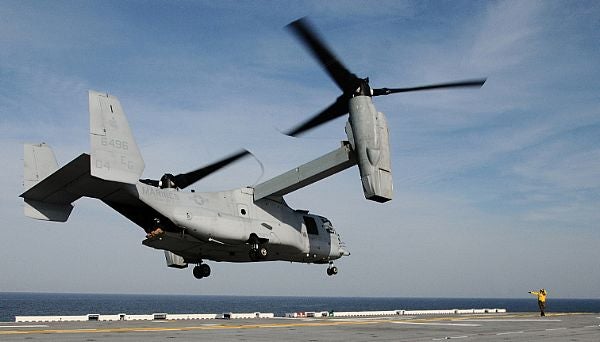
The US Marine Corps’ (USMC) MV-22 Osprey tilt-rotor aircraft has performed landing mission aboard Japanese Maritime Self Defense Force (JMSDF) ships for the first time off the Southern California coast.
Conducted as part of multinational amphibious exercise Dawn Blitz 2013, the MV-22 Osprey aircraft will land onboard JMSDF’s Osumi-class LST JS Shimokita (LST 4002) and Hyuga-class helicopter ship JS Hyuga (DDH 181) to validate its capabilities.
Before flying ashore from the JS Hyuga, the crew will also demonstrate the MV-22 aircraft’s utility and perform a humanitarian assistance and disaster relief (HADR) operations, shutdown, tow procedures, as well as lower and raising the ship’s elevator.
Commenting on the exercise, 1st Marine Expeditionary Brigade (MEB) commanding general brigadier general John Broadmeadow said the aim was to improve working relationships and demonstrate the MV-22 Osprey capabilities, which enables Marine Corps to quickly respond to a crisis from sea or land.
Scheduled to conclude on 28 June, the exercise’s synthetic-based portion was completed earlier this year, while the live portion includes more than 5,000 personnel from the US, Canada, Japan and New Zealand, as well as military observers from seven countries.
The crew will conduct large-scale amphibious assaults, sea-basing operations, mine warfare operations, live-fire opportunities, maritime prepositioning of forces (MPF), and battle-space shaping operations to test their ability to plan and execute complex amphibious operations from ship-to-shore.
Additional missions involved in the drill are training for force-on-force, special operations, infantry immersion and medical procedures, as well as operational planning, shipboard driver qualification, raids, MV-22 takeoffs and landing aboard a Japanese ship, and the largest multilateral amphibious landing.
Designed for expeditionary assault, raid operations, cargo lift and special warfare, the MV-22B aircraft features composite materials, fly-by-wire flight controls, digital cockpits and provides vertical takeoff and landing, and short takeoff and landing capabilities, as well as in-flight refuelling procedures.
Image: An MV-22B aircraft lands aboard USS Bataan (LHD 5). Photo: courtesy of US Navy, by mass communication specialist 2nd class Julio Rivera/Released.








